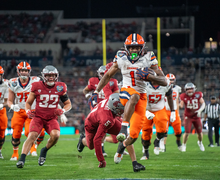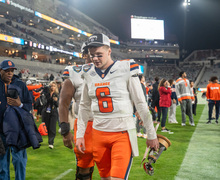Engineering students design modular padding for skateboarders at first Invent@SU
Kai Nguyen | Photo Editor
Tiago Zanaga Da Costa and Lucas Lin designed protective gear for skateboarders as part of Invent@SU.
After a few falls and scrapes to his arms while longboarding in New York City this past summer, Tiago Zanaga Da Costa wondered why he wasn’t wearing any protective gear. That’s when he realized that he could develop comfortable, low-profile gear he’d want to wear in the program that brought him to Manhattan: Invent@SU.
Da Costa, a junior computer science and engineering major at Syracuse University, and his partner Lucas Lin, junior mechanical engineering major at SU, worked alongside nine other teams for six weeks as part of the first Invent@SU program. Invent@SU gives students the opportunity to invent and innovate an original idea each week and then present that idea to professional evaluators.
Da Costa and Lin presented their protective gear idea the first week. By the end of the week, they began working with mentors to begin developing their invention — PhalHex modular padding.
“One of the big things we were doing in the beginning was that we were over-answering questions,” Da Costa said. “Which opened up for them to find the bigger holes in our product, especially earlier on when we didn’t have an idea as concrete nor a design that’s finished.”
Each week they developed the modular padding, testing materials and concepts, Lin said. After testing two prototypes, they narrowed it down to the final, went on to file a provisional patent and prepared for the presentation.
“It was all during the last week,” Lin said. “We had to stay till around midnight, starting around 11 a.m., and sometimes we came in earlier.”
They decided on PhalHex for their product name because of its dual-description, Da Costa explained. “Phal” comes from phalanx, the war formation used by the Greeks in which they would line up shields to build a wall, and “Hex” to describe the hexagonal padding that users can change around depending on their preferences.
At the end of the sixth week, the two students presented their prototypes and patents to a board of 10 judges, including business professionals across different markets and Teresa A. Dahlberg, dean of the College of Engineering and Computer Science. Dahlberg helped bring the Invent@SU program to the university after her time at the Cooper Union for the Advancement of Science and Art, where the Invention Factory program was created by professors Alan Wolf and Eric Lima.
 Courtesy of Invest@Syracuse
Courtesy of Invest@Syracuse
Each week, Dahlberg said the students improve on their prototype and improve on the way they discuss it in a pitch. Sometimes, she said, they may have to change direction if their idea turns out to not be patentable.
Dahlberg explained that all students face challenges similar to these because they make them better inventors and engineers.
“But that’s a learning experience in itself,” she said. “If you’re an inventor or an entrepreneur, and you never fail, you never tried hard enough. Learning what doesn’t work is part of what helps you move to find what does work.”
Industrial and interaction design professor James Fathers was one of the mentors of the Invent@SU summer program, held on the university’s campus.
Although he never worked directly with Da Costa and Lin, Fathers said he looked at their product online and saw they had a product to push forward into a clearly-identified market.
“One of the bear traps in this sort of development is knowing when to use the experience you’ve got to leverage another opportunity or hold on and see if you can make some money about this idea,” Fathers explained. “As a design teacher, sometimes I tell students that design is cheap, but sometimes the experiences you get in developing those designs is the most valuable piece.”
After the last few late nights and the prior weeks of development, Da Costa and Lin described the final presentation with one word: nerve-wracking. The inventors presented their developed prototype in what Dahlberg explained as a “Shark Tank” style, with professionals choosing which inventions were the best.
Lin said that one of the final judges started a company that produced wrestling helmets, so he knew a lot about the sports protection industry. Da Costa and Lin added they liked having a professional in their field on the final panel because they have gone to him for advice following the presentation.
The student inventors said their school schedules make it tough to continue developing the prototype, but that they hope to find the time for improving their design for future competitions. Da Costa said their next steps involve planning to set time aside to “figure out how to solve a couple of the issues that we had and concerns that were raised.”
Published on January 24, 2018 at 7:55 pm
Contact Connor: cbfogel@syr.edu





